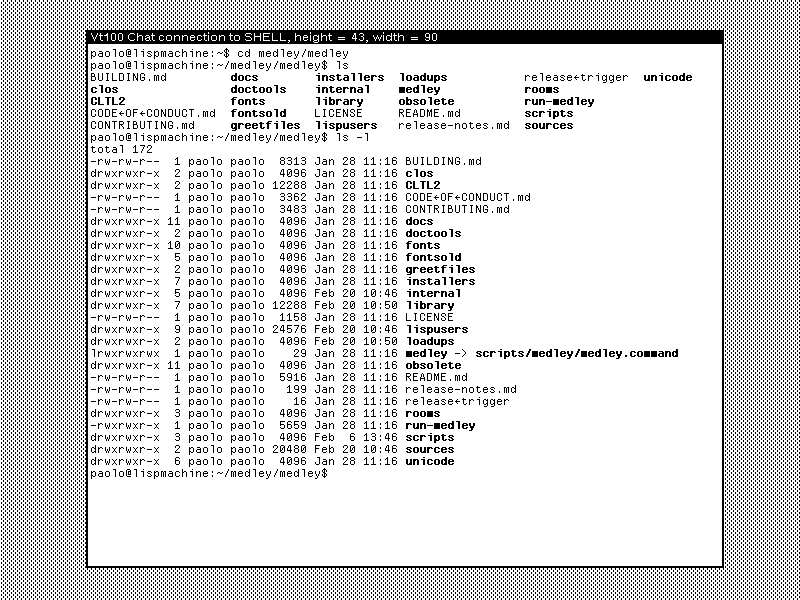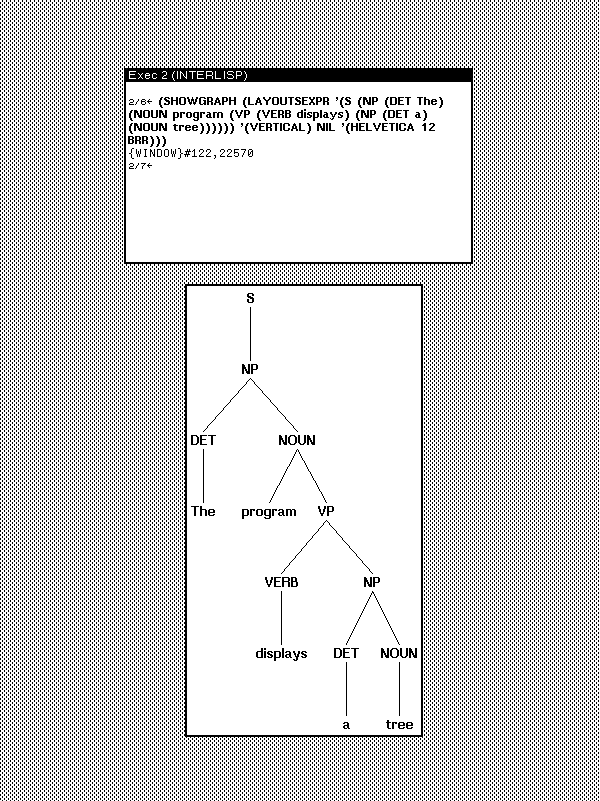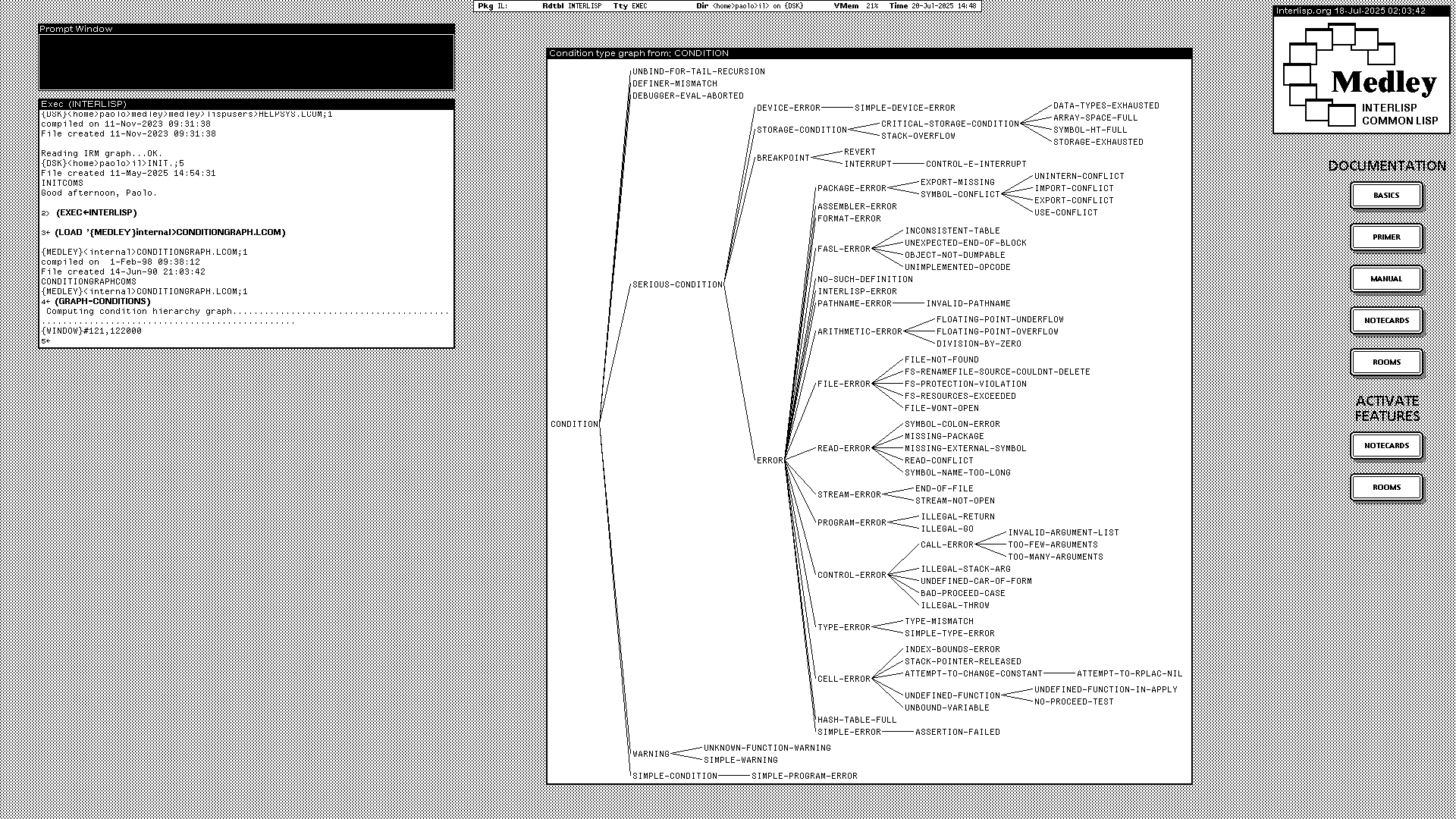Medley Interlisp supports the "process", a feature we now call "thread" as the Lisp terminology predated modern threads. The system makes wide use of processes and the Interlisp Reference Manual describes the API:
interlisp
CLISP (Conversational LISP) is the Algol-like infix notation of Interlisp. Chapter 23 of the 1978 edition of the Interlisp Reference Manual (page 554 of the PDF) explains the design goals of the notation and how it integrates with the prefix syntax of Lisp.
https://www.softwarepreservation.org/projects/LISP/interlisp/Interlisp-Oct_1978.pdf#page=554
This 1983 Xerox PARC report documented the state of Interlisp at the time. It collected papers about the Interlisp environment and programming style, development status, and implementation.
https://bitsavers.org/pdf/xerox/parc/techReports/CIS-5_Papers_on_Interlisp-D_rev_198301.pdf
Since I'm playing with Interlisp-10 on TWENEX I put together a reading list of documentation to get familiar with DEC's operating system.
https://archive.org/details/tops-20-users-guide
https://archive.org/details/tops-20-commands
The Interlisp documentation has a distinctive style that conforms to "Xerox Publishing Standards: A Manual of Style and Design" published in 1988 in this edition. It was the Xerox house style, i.e. the style guide for company publications and documents. The manual covered everything from the publishing process to visual design.
Published in 1986, "INTERLISP: The Language and Its Usage" by Stephen Kaisler was the only book on Interlisp printed by a publisher. It extensively covers the Interlisp language and environment with many code snippets and examples.
https://interlisp.org/documentation/1986-interlisp-language-book-1.pdf
Codeberg deployed Forgejo v13.0.0 which now detects Interlisp sources and handles them as text rather than binary files. We thank the developers who implemented the feature, @forgejo and @Codeberg for widening the choice of tools and code forges for hosting Interlisp software.
#lispyGopherClimate we are rolling around to that 8am-UTC Sunday-morning-in-Europe #lisp #peertube #live by request, covering #interlisp as well as #lispGameJam , #lisp generally. Live in a moment on https://toobnix.org/w/gXLXQqxf5MYg1NDF2Ua6oA as every week...!
Regardless of how ept or able I am feeling. #lisp on liberachat #irc please !
@interlisp @amoroso
autumn Lisp Game Jam 2025 - itch.io
https://screwlisp.small-web.org/lispgames/actual-game-gamejam/
Ryan Burnside entered the Autumn Lisp Game Jam 2025 with Interlisp Hungarian Rings, a puzzle he wrote in Interlisp. The project page provides instructions for downloading and playing the game:
Chat is the remote terminal and terminal emulator facility of Medley Interlisp, here showing a local Linux shell.
At this time Chat can't connect to remote hosts because the network stack of Medley is no longer functional.
The NoteCards hypermedia system was developed in Interlisp at Xerox PARC by @fghalasz Frank Halasz, Tom Moran, and Randy Trigg. In this 1985 videotape Moran introduced the main concepts of NoteCards, and Halasz demonstrated how to use the system to organize notes and sources for writing a research paper.
https://archive.org/details/Xerox_PARC_Notecards_Tom_Moran_and_Frank_Halasz_1985-01-08
Larry Masinter @masinter and Frank Halasz @fghalasz will be the guests of the next episode of "Do you speak tech?", the show Patrick Domanico hosts at Near FM community radio in Dublin. They will chat about Medley Interlisp, their memories of Xerox PARC, the computing world then and now, and more.
On March 10, 2025 at 19:00 UTC tune in to 90.3fm in the Dublin area or listen online here:
We maintain a collection of references and quotes of what people are saying about Medley Interlisp. News stories, blog posts, online discussions, and social posts offering nice words and impressions of the system. Thanks to all!
In 1976 Robert S. Boyer at SRI and J Strother Moore at Xerox PARC invented the Boyer-Moore fast string-search algorithm. Moore wrote in Interlisp the first implementation which was "10 to 50 times faster than the existing routines for searching for strings in a file", as Warren Teitelman noted in the 1976 annual report on Interlisp:
LispUsers is a collection of user contributed software that has been shipping with Interlisp and later Medley since the 1970s. To load a LispUsers program evaluate (IL:FILESLOAD file) where `file` is the program name without extension. Most come with .pdf or .TEDIT documentation that explains how to run the program.
Published in 1987, "Xerox LOOPS, A Friendly Primer" is a concise tutorial to the LOOPS (Lisp Object-Oriented Programming System) object extension of Interlisp. Some chapters of this copy are in the wrong order but all the content is there.
You can use the Interlisp function SHOWGRAPH to display a graph of an S-exp laid out by LAYOUTSEXPR, as in this example of the syntax tree of a setence. More details in the documentation of the grapher library module of Medley:
On May 28, 2025 Eleanor Young will give the talk "The Medley Interlisp Project: Reviving a Historical Software System" at the 2025 IEEE Canadian Conference on Electrical and Computer Engineering and Industry Summit (CCECE). She will discuss what other historical software recovery groups can learn from the Medley Interlisp Project.
We are happy to share the preprint and slides of the paper "The Medley Interlisp Project: Reviving a Historical Software System" by Eleanor Young et al.:
https://interlisp.org/documentation/young-ccece2025.pdf
https://interlisp.org/documentation/young-ccece2025-slides.pdf
It tells the first 5 years of the Medley Interlisp Project and discusses what other historical software recovery groups can learn from our experience. The paper was presented at IEEE CCEECE 2025 in Vancouver and accepted for publication.
The Common Lisp implementation of Medley Interlisp is closer to CLtL1 than ANSI but does support the condition system. The CONDITIONGRAPH tool shows the hierarchy graph of conditions.
In the Medley Interlisp documentation and literature the word "button" was used as a verb for mouse gestures for which we would now say "click". For example:
"Left-buttoning the display window updates it, and middle-buttoning the window brings up a menu that allows you to change the display state."
An introduction to the usage and design of SEdit, the structure editor for Lisp code of Medley Interlisp:
https://files.interlisp.org/medley/docs/internal/sedit/old/intro.tedit.pdf
For more details on the usage and internals of SEdit see (especially code-editing.tedit.pdf):




